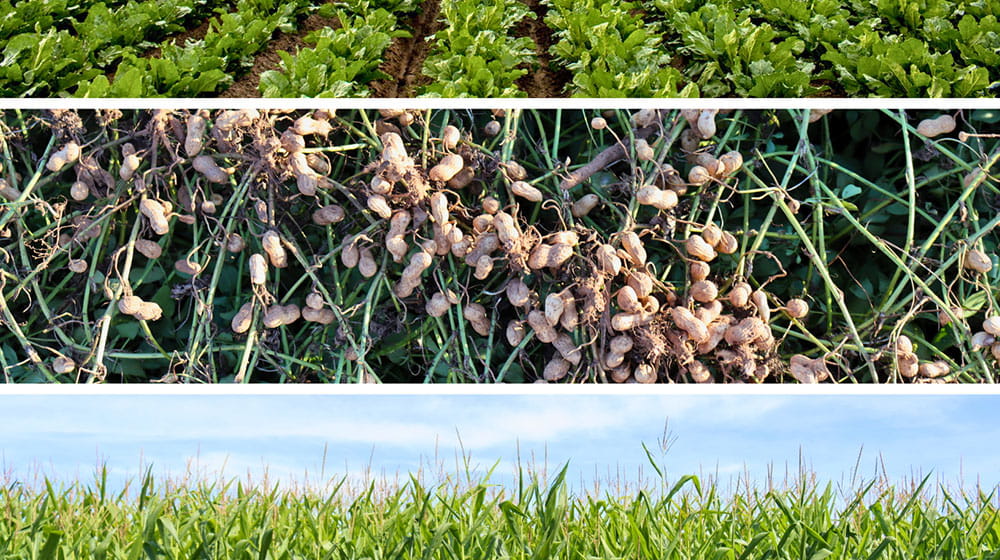Background
Vive Crop Protection sought to reimagine prothioconazole delivery with a new solution, Phobos® FC. Unlike conventional offerings, Phobos FC utilizes Vive’s patented nano-polymer technology to deliver exceptional disease control, unmatched application consistency, and faster dissolution and bioavailability to the plant across key crops like corn, sugarbeets, and peanuts.
Through extensive trials and market positioning research, Vive evaluated how Phobos FC compared to other products. The objective was clear: demonstrate how Phobos FC could outperform established market leaders on performance, ease of use, and field consistency to maximize performance in the field.
Challenge
Prothioconazole-based fungicides dominate the DMI (Demethylation Inhibitors) segment for disease control, particularly in crops such as sugarbeets and peanuts. However, other similar products are known to have application inefficiencies, such as uneven leaf coverage due to the "coffee ring effect" and increased product wash-off.
- Phobos FC development objectives focused on improving:
- Superior performance under disease pressure
- Increased active ingredient coverage and adherence to leaves
- Proven compatibility with liquid fertilizers, micronutrients, and other crop inputs
- Provides growers with measurable economic benefits, saving time and resources while boosting yield and ROI
To quantify and communicate the real-world benefits of Phobos FC, Vive employed a multi-faceted research and trial strategy:
1. Side-by-side field trials
Across multiple regions (Minnesota, Michigan, Georgia, North Carolina and South Carolina) and on a variety of crops (corn, sugarbeets, peanuts) Vive ran head-to-head trials comparing Phobos FC to industry standards. Trials included high-pressure disease environments and varying application timings, including both foliar and in-furrow approaches.
2. Laboratory imaging and leaf surface retention tests
Using fluorescent imaging and simulated rainfall protocols, Phobos FC’s rain wash-off and active ingredient coverage were evaluated. The aim was to provide quantifiable visual proof of Phobos FC’s ability to stay on the leaf and deliver the active ingredients better than competitors.
3. Mixing and compatibility trials
To validate in-field usability, Phobos FC was tested in mixes with commonly used fertilizers and micronutrients (e.g., 10-34-0, Manganese EDTA, Boron EDTA). Ease of mixing, solution uniformity, and convenience to the grower were key considerations.
Key insights
1. Enhanced application uniformity
Phobos FC demonstrates advanced application advantages due to its smaller particle sizes, ensuring better distribution across the leaf surface. This results in increased leaf coverage for more uniform disease protection, faster uptake and bioavailability for more effective control, and reduced ridging and clumping compared to competitor products, ultimately delivering more consistent and even protection for the crop.
2. Decreased rain wash-off
The amount of active ingredient retained on the leaf surface after a simulated rain event was significantly higher in Phobos FC than competitors. Phobos FC retained 60% of active ingredient post-rain simulation vs. just 30% with competitors. When paired with a tebuconazole, it retained 84% of the product compared to 37% with another competitor’s product.
3. Disease control and yield advantage
In Crookston, MN and Sebewaing, MI, Phobos FC consistently outperformed its competitors in disease protection (CLS) and recoverable sugar per acre (RSA) when used in a foliar application on sugarbeets. In trials gauging RSA and percent sugar, Phobos FC delivered the highest RSA and percent sugar across four locations, with no phytotoxicity reported even when tank-mixed with NIS.
4. Compatibility and ease of use
Phobos FC demonstrated seamless mixing with liquid fertilizers, micronutrients, and other crop inputs. The ease of tank mixing was particularly valued by users who frequently faced clumping and instability issues with legacy prothioconazole formulations.
Results
Phobos FC demonstrated its strength not only in superior disease protection and yield increase, but in creating a better user experience:
- +15–20% more leaf coverage under lab testing
- 2x more product retention post-rain compared to competitor products
- Superior disease protection in corn, sugarbeets, peanuts, canola, and more!
- Highly compatible with a wide range of fertilizers, micronutrients, and other crop inputs
These results supported Phobos FC’s positioning as a next-generation fungicide that brings tangible value across every acre.
Market impact
Growers, retailers, and COIs who trialed Phobos FC reported increased confidence recommending it as a replacement for both solo and premix prothioconazole products. Early market adoption was strongest in:
- Sugarbeet regions where Cercospora leaf spot disease pressure is high
- Peanut-producing states where application timing and PHI flexibility are critical
- Corn regions where fusarium or tar spot are prevalent and where unacceptable levels of mycotoxins are a concern.
As a result, Vive began capturing shares in both the solo prothioconazole market and in the premium premix category. If an additional active ingredient is needed to increase the disease spectrum, consider a Phobos FC + AZterknot® tank mix.
Conclusion
Phobos FC has delivered on its promise to be more than just another prothioconazole fungicide. Powered by advanced nanotechnology, it empowers growers to make every application count, delivering better disease control, less product waste, and ultimately higher yields.
Important: Always read and follow label instructions. Allosperse®, Phobos®, and Precision Chemistry® are registered trademarks of Vive.




